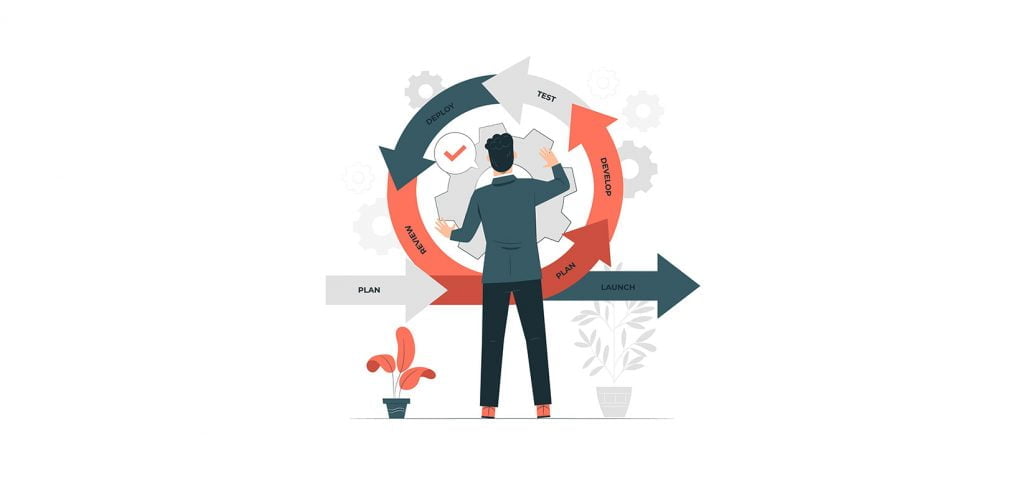Методики Agile и Scrum. Готовимся к собеседованию

Друзья, приветствую! Надеюсь, что ваш кофе горячий, и вы готовы глубже погрузиться в мир Agile и Scrum. Эта статья нацелена на тех, кто стремится подготовиться к интервью на темы Agile и Scrum, и на объяснение, как эти методики используются в IT-сфере.
Agile — это подход к разработке программного обеспечения, основанный на гибкости, интерактивности, участии клиента и постоянном улучшении. Scrum является одной из методологий Agile, которая организует работу команды вокруг коротких, интенсивных циклов работы, называемых спринтами.
Основы Agile и Scrum
Agile начал свое развитие в середине 1990-х годов в отрасли разработки программного обеспечения, где остро столкнулись с необходимостью быстрой адаптации к изменяющимся требованиям и технологиям. Стандартные водопадные модели разработки, которые требовали длительного планирования и были медленны в изменении, уже не справлялись с быстро меняющейся реальностью.
В 2001 году группа специалистов по разработке ПО собралась в курортном отеле в горах Юты, США, чтобы обсудить эти проблемы. Это собрание привело к созданию «Манифеста Agile», который представлял собой набор принципов для более гибкой и адаптивной разработки ПО. С тех пор Agile развивается и применяется во многих отраслях и сферах бизнеса.
Принципы Agile
- На первом месте — удовлетворение потребностей заказчика через раннюю и непрерывную поставку ценного программного обеспечения.
- Изменения в требованиях приветствуются, даже на поздних стадиях разработки. Agile процессы позволяют использовать изменения для обеспечения заказчику конкурентного преимущества.
- Работающий продукт следует предоставлять как можно чаще, с предпочтительной частотой от пары недель до пары месяцев.
- За процессом разработки могут следить люди, работающие вместе: бизнес-партнеры и разработчики.
- Проекты строятся вокруг мотивированных людей. Необходимо создать условия, обеспечить информацию и удалиться, позволив им работать.
- Наиболее эффективный способ передачи информации — личный разговор лицом к лицу.
- Работающий продукт — основной показатель прогресса.
- Agile процессы позволяют поддерживать постоянный темп разработки.
- Непрерывное внимание к техническому совершенству и хорошему проектированию повышает гибкость.
- Простота — искусство минимизации количества работы.
- Лучшие архитектуры, требования и проекты создаются самоорганизующимися командами.
- Команда должна регулярно анализировать способы повышения эффективности и соответственно корректировать стиль работы.
Краткое описание Scrum как одного из подходов Agile
Scrum был впервые представлен в 1986 году в статье Хиротаке Такеути и Икудзиро Нонака в «Harvard Business Review». В статье описывалась новая подход к управлению проектами, который был больше похож на регбийную команду, идущую к единой цели, нежели на традиционную водопадную модель.
Однако Scrum, как мы его знаем сегодня, начал формироваться в 1990-х годах благодаря работе Кена Швабера и Джеффа Сазерленда. Они структурировали Scrum, представив его как фреймворк для управления проектами, и в 1995 году они вместе представили свою модель на конференции ООПСЛА.
С тех пор Scrum стал одним из наиболее популярных фреймворков Agile, используемых в разработке программного обеспечения.
Scrum – это рамочная методология, которая преобразует сложность в простоту через короткие, постоянные циклы улучшений, называемые спринтами. Эта модель предполагает вовлечение всех участников проекта в планирование, проработку и отчетность о проделанной работе.
Основные термины и понятия в Scrum
Scrum включает в себя множество терминов и понятий, которые помогают организовать процесс разработки. Вот некоторые из них:
- Scrum Team: Команда Scrum состоит из Product Owner (владельца продукта), Scrum Master (мастера Scrum) и команды разработчиков.
- Product Owner: Это лицо, ответственное за управление бэклогом продукта и обеспечение высокой стоимости продукта.
- Scrum Master: Этот участник команды обеспечивает следование Scrum-процессам, помогает команде работать более эффективно и устраняет препятствия.
- Development Team: Группа профессионалов, которые работают над созданием и тестированием продукта.
- Product Backlog: Список всего, что нужно сделать для продукта. Владелец продукта управляет бэклогом и определяет приоритеты задач.
- Sprint: Определенный период времени (обычно 2-4 недели), в течение которого команда работает над выбранными задачами из бэклога.
- Sprint Backlog: Набор задач, выбранных для выполнения в текущем спринте.
- Daily Scrum (или Stand-Up): Короткая (обычно не более 15 минут) ежедневная встреча, на которой команда обсуждает прогресс и планы на ближайший день.
- Sprint Review: Встреча в конце спринта, на которой команда демонстрирует выполненную работу и получает обратную связь.
- Sprint Retrospective: Это сессия, которая проводится после Sprint Review, и на которой команда обсуждает, что пошло хорошо, что пошло не так, и как можно улучшить процесс в следующем спринте.
- Increment: Результат работы за спринт, функциональное дополнение к продукту, готовое к использованию.
- Definition of Done (DoD): Список критериев, которые должны быть выполнены, чтобы задача или продукт были признаны готовыми.
- User Story: Краткое описание функциональности продукта с точки зрения пользователя. Обычно включает в себя роль пользователя, его цель и причину.
- Epic: Большая единица работы, которая может быть разбита на множество меньших задач или user stories. Эпики часто используются для описания сложных функций или изменений на высоком уровне.
- Velocity: Метрика, которая показывает количество работы, которое команда способна выполнить за один спринт. Обычно измеряется в story points.
- Story Points: Оценка сложности задачи. Это относительная мера, используемая для оценки сложности работы, а не времени, необходимого для ее выполнения.
- Burn-Down Chart: Диаграмма, которая показывает, сколько работы осталось сделать в течение спринта или проекта.
- Impediment: Любое препятствие или проблема, которая мешает команде эффективно работать.
- Refinement (Grooming): Процесс пересмотра и уточнения бэклога продукта, включая оценку и приоритизацию задач.
- Timeboxing: Ограничение времени, предназначенное для выполнения определенной задачи или активности. В Scrum все события (Daily Scrum, Sprint Planning, Sprint Review, Sprint Retrospective) имеют строгие временные рамки.
- Scrum Board: Визуальная доска (часто в виде доски Kanban), на которой отображается прогресс работы в текущем спринте. Она может быть разбита на разделы, такие как «To Do», «In Progress» и «Done».
- Sprint Zero: Спринт, используемый для планирования и подготовки к началу проекта. В нем могут быть разработаны важные артефакты, такие как бэклог продукта.
- Release Planning: Процесс планирования релизов продукта в течение времени. Это может включать в себя определение основных функций, которые должны быть включены в каждый релиз, и планирование, когда эти релизы будут происходить.
- Stakeholder: Любой человек или группа, которые имеют интерес или вклад в проект или могут быть затронуты его результатом.
- Acceptance Criteria: Специфические условия, которые определяют, когда задача считается выполненной и функция готовой к использованию.
- Spike: Временная задача, направленная на исследование или устранение неопределенности. Spike может быть использован для исследования новой технологии или разработки прототипа.
- Technical Debt: Метафора, описывающая последствия выбора быстрых, но потенциально ненадежных решений, которые в долгосрочной перспективе могут потребовать больше времени на исправление или поддержку.
- Product Increment (PI): Общая сумма всех бэклог элементов продукта, выполненных в течение спринта.
Это далеко не все термины, но они дадут хорошее представление о ключевых концепциях в Scrum.
Роль разработчика в Agile и Scrum
Обязанности разработчика в Scrum команде
Разработчик в Scrum команде имеет несколько обязанностей:
- Проектирование и реализация функций продукта.
- Участие в планировании спринта и выборе задач из бэклога.
- Сотрудничество с другими членами команды для решения сложных задач.
- Участие в ежедневных встречах Scrum и в ретроспективе спринта.
Как взаимодействовать с другими членами команды
Важно помнить, что Scrum — это не только о процессах, но и о людях. Учиться работать в команде и быть готовым помочь коллегам — важная часть работы в Scrum. Также, важно уметь общаться с продуктовым владельцем, чтобы понимать ожидания и требования к продукту, и с Scrum-мастером, чтобы помочь улучшить работу команды.
Просто знать терминологию Scrum недостаточно. Работодатели хотят видеть, что вы понимаете и можете применять принципы Agile и Scrum. Вам нужно показать, что вы можете работать в команде, быть гибким и адаптироваться к изменениям, и вы уважаете ценности Agile.
Советы по подготовке к собеседованию
1. Понимание Agile и Scrum
Собеседование на позицию разработчика в Scrum команде не только о проверке технических навыков, но и о проверке вашего понимания методологии Agile и Scrum. Убедитесь, что вы знаете основные принципы Agile, а также специфические элементы Scrum, такие как роли, артефакты и события.
2. Умение применять Scrum
Просто знание теории Scrum недостаточно. Вам нужно показать, что вы можете применять Scrum на практике. Подумайте о проектах, в которых вы использовали Scrum, и будьте готовы рассказать о них.
3. Понимание ценностей и принципов Agile
Agile ориентирован на людей и сотрудничество, поэтому важно показать, что вы разделяете эти ценности. Возможно, вас попросят рассказать о ситуации, когда вы применяли эти принципы на практике.
4. Знание ситуационных вопросов
Подготовьтесь к ситуационным вопросам, связанным с Agile и Scrum. Например, «Что вы бы сделали, если бы вам пришлось внести значительные изменения в проект в середине спринта?» или «Как вы бы общались с членом команды, который не согласен с оценкой задачи?»
5. Ответы на типичные вопросы
Подготовьтесь к ответам на типичные вопросы на собеседованиях по Agile и Scrum, такие как «Что такое Scrum?» или «Можете ли вы объяснить принципы Agile?» Будьте готовы дать четкие и краткие ответы. Выучите всю основную терминологию.
6. Технические навыки
Не забывайте о своих технических навыках. Вам могут задать вопросы, связанные с программированием, архитектурой программного обеспечения, системами контроля версий и другими техническими аспектами.
7. Подготовка к вопросам о командной работе
Scrum — это командная методология, поэтому вы, вероятно, столкнетесь с вопросами о командной работе и взаимодействии. Будьте готовы рассказать о вашем опыте работы в команде, о ваших достижениях и о том, как вы справлялись с конфликтами или проблемами.
8. Постоянное обучение и развитие
Мир IT и технологий постоянно развивается, и Agile подчеркивает важность адаптации и обучения. Будьте готовы обсудить, как вы продолжаете развиваться как профессионал, какие книги по Agile и Scrum вы читали, какие курсы прошли, какие сертификаты получили.
9. Решение проблем
Вам может быть предложена задача на решение проблемы или case study, связанный с Agile и Scrum. Это хороший шанс продемонстрировать свое практическое понимание методологии и того, как она может быть применена для достижения целей и решения проблем.
10. Активное участие
Не забывайте, что собеседование — это также ваш шанс узнать больше о компании, ее культуре и о том, как она применяет Agile и Scrum. Не бойтесь задавать вопросы и быть активным участником разговора.
Подготовка к собеседованию по Agile и Scrum требует глубокого понимания концепций и принципов, а также практического опыта их применения. Уделите время подготовке, и вы сможете успешно пройти собеседование и продемонстрировать свою ценность как Agile разработчика.
Общие заблуждения о Agile и Scrum
1. Agile = Без плана
Многие ошибочно полагают, что Agile подразумевает отсутствие плана. На самом деле, Agile подчеркивает важность гибкости и постоянного адаптивного планирования. План в Agile есть, но он динамичный и может меняться в ответ на меняющиеся потребности и обстоятельства.
2. В Scrum всё может меняться в любой момент
Это еще одно распространенное заблуждение. Хотя Scrum действительно поддерживает гибкость, изменения в работе во время спринта должны минимизироваться. Это помогает команде сосредоточиться на задачах спринта и достичь целей спринта.
3. Scrum-мастер = Лидер команды
Scrum-мастер — это не традиционный «лидер» или «менеджер». Это скорее роль-фасилитатора, помогающего команде применять Scrum правильно. Scrum-мастеры помогают убрать препятствия и создают условия для эффективной работы команды, но не управляют ею в традиционном смысле.
4. Agile и Scrum подходят для любого проекта
Хотя Agile и Scrum имеют множество преимуществ, они не всегда являются лучшим выбором для всех проектов или организаций. Некоторые проекты могут требовать более формализованного подхода или подходят для других методологий проектного управления.
5. Каждый член Scrum-команды должен заниматься всем
В Scrum-командах участники часто работают над разными задачами, но это не означает, что все должны быть специалистами во всем. Хотя важно иметь некоторое разнообразие навыков и способность поддерживать друг друга, это не означает, что каждый член команды должен быть экспертом во всех областях.
Типичные ошибки разработчиков в Scrum командах
1. Недостаток коммуникации
Scrum сильно полагается на активную и открытую коммуникацию. Без нее, команда может столкнуться с проблемами координации, проблемами с выполнением задач и недопониманиями. Если вы не коммуницируете достаточно активно или не делитесь информацией, это может привести к проблемам.
2. Игнорирование принципов Agile
Некоторые разработчики сосредотачиваются на технической стороне работы, забывая о принципах и ценностях Agile. Это может привести к ситуации, когда процессы становятся «слишком важными», а сама суть Agile теряется.
3. Неэффективное использование собраний Scrum
Собрания Scrum, такие как Daily Scrum, Sprint Planning, Sprint Review и Sprint Retrospective, предназначены для обеспечения прозрачности и повышения эффективности команды. Однако, если эти встречи воспринимаются как обязательная рутина, а не как инструмент для облегчения работы, они могут стать тратой времени.
4. Отсутствие уважения к границам спринта
Разработчики могут пытаться добавить больше работы в спринт, чем это возможно, или менять задачи в середине спринта. Это может привести к перегрузке работы и ухудшению качества.
5. Избегание ответственности
В Scrum, ответственность за успех спринта лежит на всей команде. Если разработчики избегают этой ответственности или пытаются переложить ее на других, это может подорвать доверие и эффективность команды.
6. Зависимость от Scrum-мастера
Разработчики могут полагаться на Scrum-мастера как на традиционного менеджера, ожидая, что он будет решать все проблемы. Однако в Scrum, команда должна быть самоорганизованной и самостоятельно решать проблемы.
Сценарии ситуационных задач и их решения в контексте Agile и Scrum
Эти примеры могут помочь вам лучше подготовиться к собеседованию, где вам могут задать подобные ситуационные вопросы. Важно помнить, что в Agile и Scrum нет «единственно правильных» ответов, и ваши решения могут зависеть от конкретных обстоятельств.
Задача 1: Срыв сроков спринта
Ситуация: Вы работаете в команде Scrum. Спринт уже на 50% своего времени, но вы обнаруживаете, что половина запланированных задач еще не начата. Кажется, что команда не сможет закончить все запланированные задачи до конца спринта. Что вы делаете?
Решение: Сначала нужно выяснить, почему произошла задержка. Может быть, оценка задач была слишком оптимистичной или встречались непредвиденные проблемы. Затем обсудить ситуацию на Daily Scrum и предложить пересмотреть объем работы для текущего спринта. Возможно, стоит перенести некоторые задачи в следующий спринт. Это позволит команде сфокусироваться на наиболее приоритетных задачах и успешно завершить спринт.
Задача 2: Мнение команды противоречит мнению стейкхолдера
Ситуация: Ваша Scrum команда считает, что для достижения одной из целей проекта следует использовать определенный технологический стек, который, по вашему мнению, будет эффективнее. Однако стейкхолдер настаивает на использовании другого технологического стека. Что вы делаете?
Решение: В первую очередь, открыто обсудите этот вопрос со стейкхолдером. Объясните вашу точку зрения, приведите аргументы в пользу выбранного командой технологического стека. Если стейкхолдер все равно настаивает на своем, попробуйте найти компромиссное решение. Важно помнить, что в Agile приоритетом является создание ценности для клиента, и иногда это может означать необходимость идти на уступки.
Задача 3: Постоянно меняющиеся требования
Ситуация: Вы работаете над проектом, где требования постоянно меняются, и это делает планирование спринтов и оценку задач сложной. Что вы делаете?
Решение: Это распространенная ситуация при работе по Agile. В таких случаях, важно поддерживать постоянную связь с клиентом или стейкхолдером. Если требования меняются, нужно гибко подстраиваться, пересматривать и перепланировать задачи в соответствии с новыми требованиями. Также может быть полезным использовать техники управления изменениями и проводить частые сессии обратной связи.
Задача 4: Низкая продуктивность команды
Ситуация: Вы заметили, что производительность вашей Scrum команды упала. Задачи выполняются медленнее, чем обычно, и команда не достигает целей спринта. Что вы делаете?
Решение: Нужно определить причину снижения производительности. Это может быть результат проблем с мотивацией, перегрузки работы, конфликтов в команде или других проблем. Сначала обсудите ситуацию в команде. Затем вы можете применить различные техники для улучшения работы команды, такие как проведение ретроспектив спринта, применение практик парного программирования или улучшение коммуникации.
Задача 5: Отсутствие продуктового бэклога
Ситуация: Приступая к новому проекту, вы обнаруживаете, что у вашего продукта нет продуктового бэклога, что затрудняет планирование и организацию работы. Что вы делаете?
Решение: В первую очередь, следует работать с Product Owner'ом или клиентом, чтобы разработать продуктовый бэклог. Это должен быть приоритетом, поскольку без бэклога сложно планировать спринты и управлять работой команды. После создания бэклога можно начать планировать спринты и организовывать работу команды.
Заключение
Подготовка к собеседованию по Agile и Scrum требует понимания принципов и практик, а также способности демонстрировать их применение. Важно не только знать ответы на типичные вопросы, но и понимать, как применять Agile и Scrum на практике.
Надеюсь, эта статья помогла вам лучше понять данные методологии и подготовиться к собеседованиям.
P.S. Любые дополнения, замечания и мысли по теме этой статьи только приветствуются 💬






Комментарии